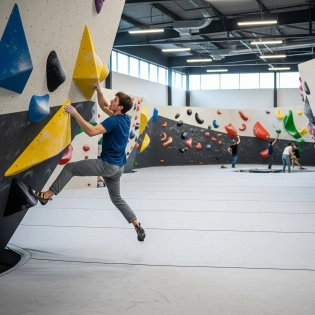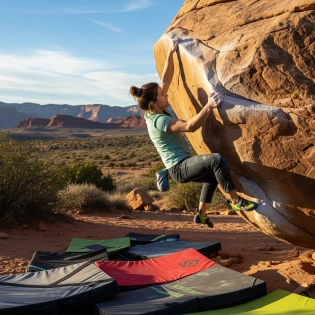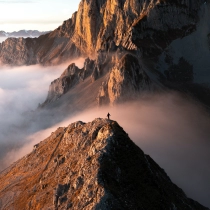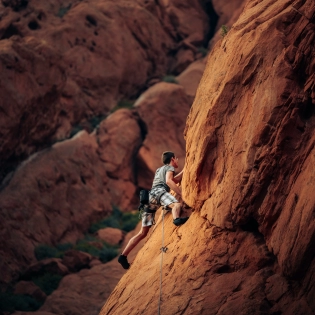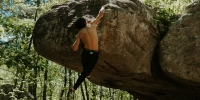
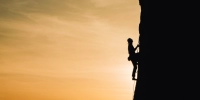

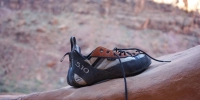




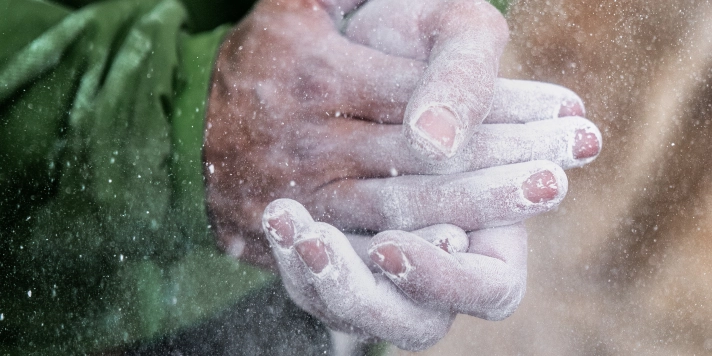
general climbing
Yeah, weight training can definitely help your climbing! When you build strength in your major muscle groups like your legs, core, back, and arms, it can make it easier to tackle more challenging climbs and prevent injuries. But keep in mind that climbing is also a skill-based sport, so it's important to keep practicing your technique and mental focus. To optimize your weight training for climbing, try exercises like squats, lunges, pull-ups, and rows. Start with a manageable weight and gradually increase it over time as you get stronger.
To stop relying solely on strength and improve your climbing technique, here are a few tips:
-
Focus on footwork: Precise footwork is essential for efficient climbing, so be sure to place your feet accurately and use them to support your weight.
-
Practice precise movement: Avoid making big, energy-wasting movements by moving efficiently and with intention on the wall.
-
Use your body positioning: Body positioning is crucial to efficient climbing, so learn to use your hips, shoulders, and arms to your advantage.
-
Climb with intention: Instead of just trying to reach the top of the route, focus on each move and try to execute it as perfectly as possible to develop good habits and reinforce proper technique.
-
Get feedback: Climbing with a partner who can give you feedback on your technique can be incredibly helpful in identifying areas for improvement.
Remember that developing good technique takes time and practice, so be patient with yourself and keep working at it. By improving your technique, you'll be able to climb more efficiently and effectively.
I think this refers to the head forward and slightly hunched back posture climbers tend to have.
Of course, not all climbers have this posture, but many do, it has become a sort of stigma, giving it the name "climbers posture".
I have a fear of sports climbing. The moment i get a little bit too far from the ground, each clip becomes more and more nerve racking and stressful.
The more I do it though, the less stressful it becomes. After just a few sessions I get used to it and the fear goes away. But, the condition is that I do this often. If I sport climb once a month, the fear doesn't go away. If I do it at least once or twice a week, the fear goes away pretty quickly.
So what helps me control my fear is actually doing it more often.
Yes, you can go bouldering alone in a climbing gym. Bouldering in climbing gym doesn't require any special safety equipment as the gyms have everything that is needed.
Bouldering outdoors, on the other hand, would require at least one more person for safety reasons. The person would be your spotter, and would be there to help in case anything goes wrong.
It helps us prevent skin injuries such as tears and flappers. if the skin is rough, it can get caught on holds and could tear, which can be a nightmare for climbers.
Filing rougher and bulgy areas of the skin helps prevent this.
They "go" in a bag or some kind of container, keep it with them until they get down from the route (or up), and then throw it away when they can.
Before lead climbing, you should at least have some experience in climbing and know the basics. Depending on how and where you want to learn lead climbing, you may be required to have some climbing experience. This experience could be a certain amount of time climbing, climbing to a certain grade, or just being familiar with climbing in general, climbing holds, and how to move on the wall. Some places are stricter than others.
If you really want to start off well, it is recommended that you get used to climbing before. This can either be from top rope, some sort of auto-belay device, or bouldering. The more experience you have with climbing, the better and easier it will be to learn lead climbing.
In terms of what level you should be climbing before you can do lead climbing, there is no rule for this. Even if you are a beginner climber, you can lead climb. Still, it is recommended to have experience in climbing before starting with lead climbing.
Climbing very often puts your body in strange and difficult positions, regardless of the type of climbing. These positions can sometimes be quite scary to be in, especially when including the element of height.
In bouldering, being almost vertical to the ground for certain routes at even a few meters off the ground can be scary, even more so in a sport or lead climbing route, where you may be over 10 meters off the ground.
Many people actually realize that they have a hidden fear of heights that only comes out while they are climbing. The different body positions you put yourself in to climb the different routes adds to the overall fear, and makes the situation that much more scary.
California is home to some of the greatest climbing destinations in the USA and in the word. Such places include Yosemite National Park, Joshua Tree National Park, Bishop, and The Needles. All of which are immensely popular climbing destinations for all types of climbing, including Bouldering, Sport Climbing, Trad Climbing, and of course, maybe very much thanks to Alex Honnald, Free-soloing. Though free-soloing was popular before, the documentary Free-Solo about Alex Honnald really gave this form of climbing, and the location, a boost in popularity.
In addition to California, there are other states and climbing destinations that are as popular as California, such as:
Red Rock, Nevada
Indian Creek, Utah
Zion National Par, Utah
Index, Washington State

